AMD’s Ryzen 7000 CPUs are here, and there are plenty of them to go around. AMD started out strong by introducing the best processors in the Zen 4 lineup, including the flagship Ryzen 9 7950X, and then followed up by launching even more CPUs. Now, the Ryzen 7000 family includes a whole host of desktop and mobile CPUs, and even the 3D V-Cache versions of AMD’s chips.
We’ve already had the chance to test some of AMD’s latest and greatest, and with more to come, we’ve kept our ears to the ground to not miss any details about the latest AMD CPUs. Here’s everything we know about Ryzen 7000.
Pricing and availability
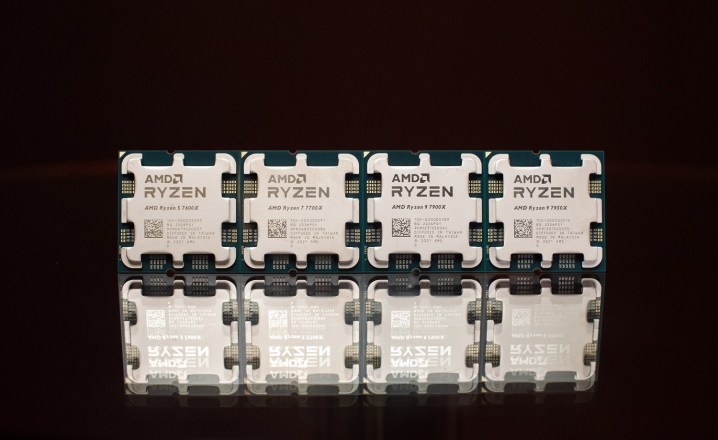
AMD Ryzen 7000 CPUs came out on September 27, 2022, a bit later than some rumors had predicted. It’s probably not a coincidence that September 27 was also the day Intel announced the competing 13th-generation Raptor Lake CPUs; perhaps AMD decided a delay wasn’t just necessary, but also welcome.
The first wave of Ryzen 7000 CPUs arrived with the following recommended prices:
- Ryzen 9 7950X: $699
- Ryzen 9 7900X: $549
- Ryzen 7 7700X: $399
- Ryzen 5 7600X: $299
Not long after their release, the processors got an unofficial discount that seems to have lasted to this day. As a result, you can find the flagship Ryzen 9 7950X for around $600, and the other chips are cheaper too.
Pricing has actually improved for the eight- and 16-core models. The 7950X is cheaper than the original 16-core flagship 3950X was when it launched in 2019. The 7700X is also cheaper than the 5800X, though it would have been nice to see the 7700X match the price of the $300 5700X, but it’s not that far off. While many people expected higher prices for most of these CPUs, we can be quite relieved that prices are either flat or lower than before.
AMD followed up by launching even more Zen 4 processors. The company revealed a massive number of chips during CES 2023, and the new lineup includes both desktop and mobile options.
For desktops, AMD announced three new chips sporting the 3D V-Cache that made the Ryzen 7 5800X3D so successful. These processors arrived February 2023, and the lineup includes the Ryzen 9 7950X3D, Ryzen 9 7900X3D, and the Ryzen 7 7800X3D. You can see how they perform in our Ryzen 7 7800X3D review and Ryzen 9 7950X3D review.
As mentioned, the Zen 4 family has also expanded to include a truckload of mobile chips that will begin popping up in some of this year’s best laptops starting in March. This range is split in two: Ryzen 7040 and Ryzen 7045. The latter are aimed at gamers, with the top chip sporting 16 cores, and the Ryzen 7040 chips are going to be found in productivity-oriented laptops that don’t consume too much power.
Specs
The Ryzen 7000 range consists of Zen 4 desktop CPUs, their 3D V-Cache counterparts, and two mobile lineups. Let’s take a look at all of their specs, starting with the desktop Ryzen 7000.
| Ryzen 9 7950X | Ryzen 9 7900X | Ryzen 7 7700X | Ryzen 5 7600X | |
| Cores/threads | 16/32 | 12/24 | 8/16 | 6/12 |
| Boost clock speed | 5.7GHz | 5.6GHz | 5.4GHz | 5.3GHz |
| Base clock speed | 4.5GHz | 4.7GHz | 4.5GHz | 4.7GHz |
| Cache (L2 + L3) | 80MB | 76MB | 40MB | 38MB |
| TDP | 170W | 170W | 105W | 105W |
The big changes with this generation of CPUs come in the form of clock speed, cache boosts, and a higher TDP to account for it. Thanks to improvements to the Zen 4 architecture and a new, more efficient 5nm process node, AMD has been able to take its Ryzen 7000 CPUs well north of 5GHz for the first time. That does come at the cost of TDP, however. Where the last-generation Ryzen 5950X had a TDP of just 105 watts, the 7950X with the same 16 cores is now rated for a 170W TDP. It actually pulled around 200W when maxed out in our testing (more on that below).
| Ryzen 9 7950X3D | Ryzen 9 7900X3D | Ryzen 7 7800X3D | |
| Cores/threads | 16/32 | 12/24 | 8/16 |
| Boost clock speed | 5.7GHz | 5.6GHz | 5GHz |
| Base clock speed | 4.2GHz | 4.4GHz | 4.4GHz |
| Cache (L2 + L3) | 144MB | 140MB | 104MB |
| TDP | 120W | 120W | 120W |
The three processors listed above utilize AMD’s 3D V-cache technology. They come with extra cache stacked on top of the chip, and the Ryzen 9 7950X3D sports a whopping 144MB — a notable increase over the Ryzen 7 5800X3D, which has 96MB. Even the direct follow-up to the 5800X3D kicks things up a notch, with a combined cache of 104MB.
| Ryzen 9 7945HX | Ryzen 9 7845HX | Ryzen 7 7745HX | Ryzen 5 7645HX | |
| Cores/threads | 16/32 | 12/24 | 8/16 | 6/12 |
| Boost clock speed | 5.4GHz | 5.2GHz | 5.1GHz | 5.0GHz |
| Base clock speed | 2.5GHz | 3.0GHz | 3.6GHz | 4.0GHz |
| Cache (L2 + L3) | 80MB | 76MB | 40MB | 38MB |
| TDP | 55-75W | 45-75W | 45-75W | 45-75W |
Coming up next, we have the Ryzen 7045-series laptop chips currently being released in four different models ranging from the high-end Ryzen 9 to the midrange Ryzen 5. In many ways, these chips share some specs in common with their desktop counterparts — they have the same core counts and cache sizes, but the clock speeds and the TDP are both lower. These processors are available in gaming laptops, such as the Asus ROG Strix Scar 17.
| Ryzen 9 7940HS | Ryzen 7 7840HS | Ryzen 5 7640HS | |
| Cores/threads | 8/16 | 8/16 | 6/12 |
| Boost clock speed | 5.2GHz | 5.1GHz | 5.0GHz |
| Base clock speed | 4.0GHz | 3.8GHz | 4.3GHz |
| Cache (L2 + L3) | 24MB | 24MB | 22MB |
| TDP | 35W-54W | 35W-54W | 35W-54W |
Lastly, the Phoenix Range processors feature cutdown specs, but are also a lot more power-conservative. The core counts are kept fairly low, but the clock speeds are still more than decent. You’ll also notice that the cache size has been drastically reduced. The drop in specifications shouldn’t be a problem, because these are not gaming chips — you’ll find them in lightweight, productivity-oriented laptops.
Architecture
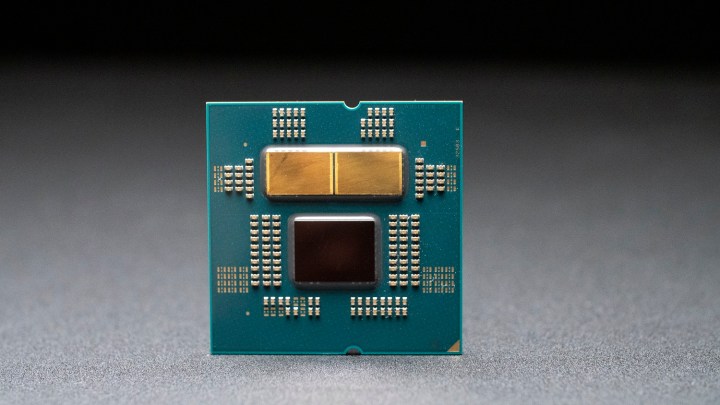
The Ryzen 7000 chips are based on the new Zen 4 architecture. It continues the evolution of the chiplet design pioneered on Zen 2 and is built on TSMC’s new enhanced 5nm process node.
The 5nm node — known as N4 at chipmaker TSMC — is said to offer either a 15% boost in clock speed at the same power or a 30% reduction in power consumption at the same frequency, in addition to 1.8 times greater transistor density over N7.
As for the design improvements of the architecture itself, AMD promised an 8% to 10% instruction per clock (or IPC) boost at its Financial Analyst Day in June, but AMD has since revised that figure to 13%. That’s a smaller improvement compared to last-gen’s Zen 3, but we haven’t talked about clock speed.
AMD has targeted extremely high clock speeds with Ryzen 7000. AMD finally hit the 5GHz mark on its Zen CPUs with Ryzen 6000 mobile and Ryzen 5000 capped out at 4.9 GHz. But Ryzen 7000 blows right past last-generation chips and features clock speeds as high as 5.7 GHz, albeit in single-threaded workloads. At the same time, Ryzen 7000 is 25% more efficient than Ryzen 5000, thanks to the 5nm node and decent IPC improvements offsetting the increase in frequency.
Cache is also a focus for Ryzen 7000, as each Zen 4 core is now equipped with 1MB of L2 cache rather than the 512KB we saw on Zen 3. L3 cache was not increased within the CPU itself, but AMD was quick to remedy that by introducing the 3D V-Cache chips that come with up to 144MB of combined cache. Counting both L2 and L3 cache, the flagship Ryzen 9 7950X has 80MB total, and a theoretical Ryzen 7 7700X3D with V-Cache could have up to 104MB.

Ryzen 7000 also features a TDP increase for its flagship parts, from 125 watts on Ryzen 3000 and 5000 to 170 watts. Prior 12- and 16-core models were constrained by the 125-watt limit, hence the increase. Another interesting change is the addition of integrated RDNA 2 graphics, but they aren’t very powerful. One might wonder why AMD would decide to add a weak iGPU to its desktop CPUs, but it’s likely because AMD wants to be able to sell this CPU in machines without discrete graphics and also in laptops such as Dragon Range. Fortunately, as you’ll see below, they might be limited, but the onboard graphics are more than enough to game on.
Those graphics are stored not on the CPU chipsets, but on the I/O die, which is now on TSMC’s 6nm node, a more economical version of its 7nm node. Graphics aren’t the only new addition to the I/O die, though, as AI acceleration features are built in as well.
Performance
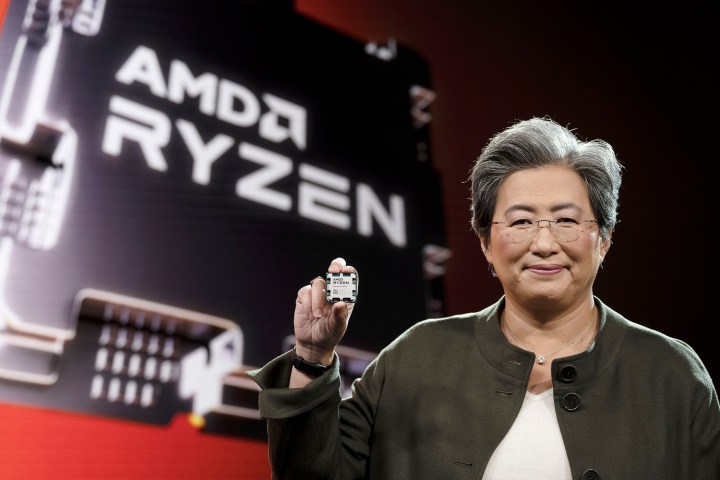
Higher IPC, higher clock speeds, and more cache are basically the perfect formula for great performance, and AMD delivered in style with Ryzen 7000. In our own testing of the 7950X, we found that it made major leaps over both the 5950X and its main competitor from Intel (for now), the Intel Core i9-12900K.
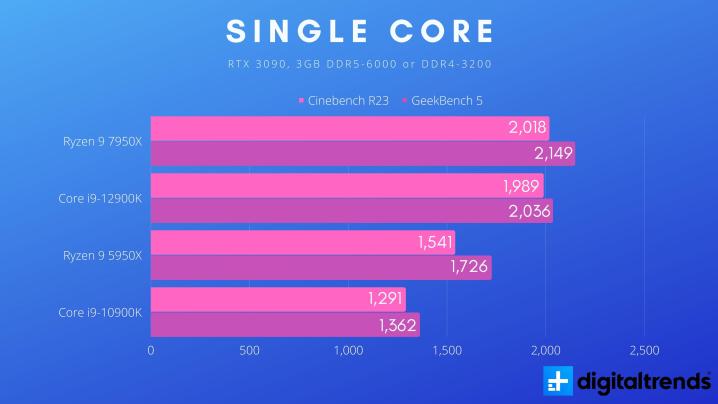
In single-core performance, the 7950X shows an impressive 31% improvement over the 5950X — that’s greater than even its ambitious 29% claims made previously. That should deliver a big boost in general compute performance and in specific applications that really thrive on extra clock speed and cache, like Photoshop.
Games also love that kind of per-core enhancement, and in our testing, the 7950X was able to handily beat the 12900K and the previous AMD gaming king, the 5800X3D.

CPUs aren’t the arbiter of gaming performance that they once were, but they still play a part, and faster CPUs can unlock additional GPU performance in CPU-bound games. In our spread of tested titles, we found the 7950X delivered around 13% higher frame rates in games on average, but in some, like Forza Horizon 4, it jumped by as much as 28% over the 5950X. It was around 10% faster than the 5800X3D, but in some games, it was as much as 18% quicker.
The 12900K offers stiffer competition in some games, but even then, the 7950X is the clear winner. Intel will have a tough fight to regain that ground with its next-generation designs.

Real-world productivity applications showed impressive gains, too, giving the 7950X the multi-threaded crown again after AMD lost it to the best Alder Lake designs. This makes Ryzen 7000 a very attractive buy for anyone using their PC for creative means.
Ryzen 7000’s main competition isn’t Intel’s 12th-gen Alder Lake; it’s 13th-gen Raptor Lake. We’ve compared the Ryzen parts to Intel’s best processors of this generation and found them often going head-to-head. Let’s take a closer look.
In synthetic benchmarks, the Ryzen 9 7950X and the Core i9-13900K were evenly matched on many occasions. In the Cinebench R23 single-core test, the Intel chip shows a slight lead over AMD that grows bigger in the multi-core test. However, when we ran the Geekbench 5 multi-core benchmark, we found that the AMD and Intel flagships scored almost exactly the same.
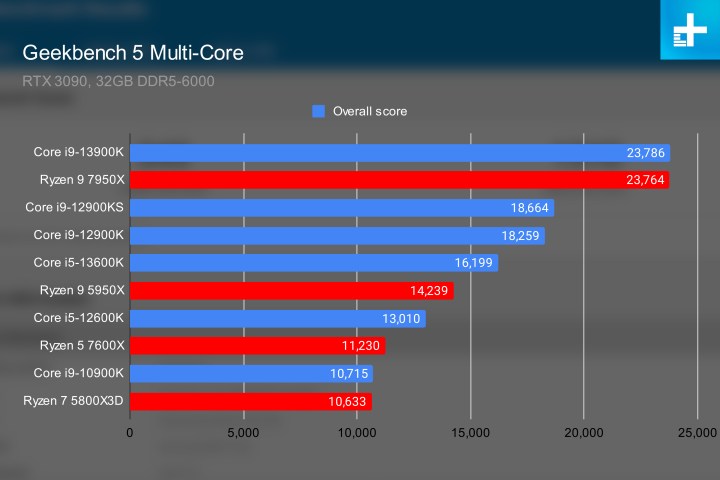
Next, we tested the processors in a gaming setting. Again, it’s safe to say that they’re butting heads, but that will change when AMD’s 3D V-Cache parts land on the shelves. Much like the Ryzen 7 5800X3D was pretty much the best gaming processor in terms of raw performance and efficiency, there’s a high chance that its Zen 4 counterparts will excel in gaming.
We paired the CPUs with an RTX 3090 and 32GB of DDR5-6000 RAM and tested them in various games. In Cyberpunk 2077 at 1080p, the AMD Ryzen 9 7950X and the Intel Core i9-13900K maintained the same frames per second (fps), averaging 128 fps. In Red Dead Redemption 2, Ryzen takes a small lead over Intel, while in Assassin’s Creed Valhalla, Intel wins by a few frames. All in all, they’re fairly even, but that may soon change in AMD’s favor when we get the chance to test the upcoming Ryzen 9 7950X3D.
New chipset and a new socket
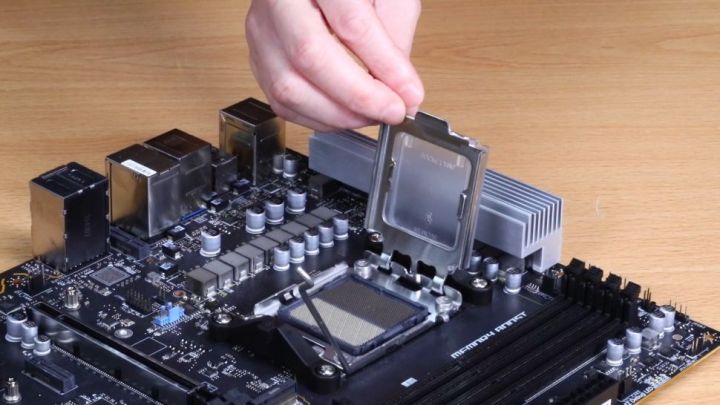
With the next generation of CPUs, AMD is retiring the AM4 socket that it has used since the launch of first-generation Ryzen chips. That shouldn’t come as a surprise, as the socket is now 5 years old.
This new socket uses an LGA1718, Land Grid Array design, with the CPU pins on the motherboard instead of on the CPU. Intel has used LGA sockets for several generations, while AMD has stuck with the older Pin Grid Array (PGA) socket design for everything up to Ryzen 5000.
As the name suggests, LGA1718 features 1,718 pins on the motherboard. LGA designs can support a higher pin density, and that’s clear to see with AM4’s mere 1,331 pins. Those additional pins help open up support for DDR5 memory, as well as PCI-Express 5.0 and improved overall performance.
Those new AM5 sockets will be part of a new generation of 600 series motherboards. The X670E extreme motherboards offer the highest-quality voltage regulator modules for enhanced overclocking and will have PCI-E 5 support on every M.2 and PCIe slot. X670 boards will feature mainstream overclocking potential, PCIe 5.0 on both the first x16 PCIe 5.0 slot, and at least one M.2 slot. B650 motherboards will have PCIe 5.0 for at least one M.2 slot and will feature PCIe 4.0 for the actual slots.
These new motherboards will bring with them support for up to 24 PCIe 5.0 lanes, 14 USB ports running up to 20Gbps, Wi-Fi 6E, and Bluetooth 5.2. Better yet, thanks to the new integrated graphics, AMD 600 motherboards will be able to support up to four HDMI 2.1 or DisplayPort 2 ports.
Although AMD is moving to a new socket design, Ryzen 7000 chips will use the same socket size and will fully support AM4 coolers.
Integrated graphics and APUs
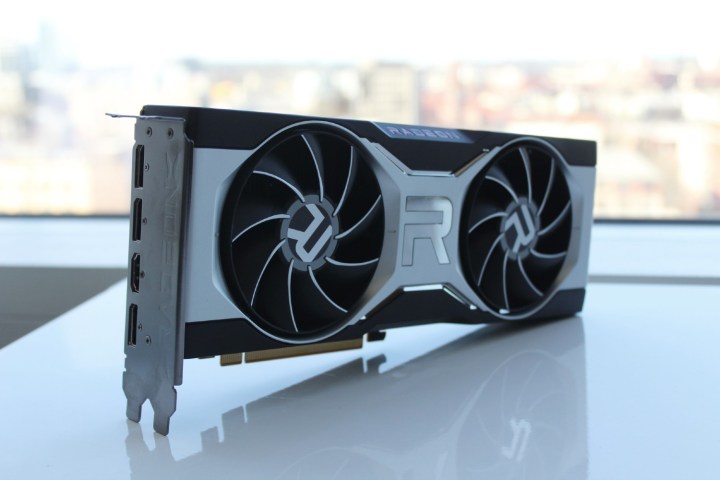
By including the GPU on the I/O die instead of the main CPU chiplets, AMD isn’t having to make any sacrifices to add integrated graphics, so all Ryzen 7000 chips will have an onboard RDNA 2 GPU. Ryzen 7000 won’t replace APUs, though. Instead, the included graphics are meant to aid in troubleshooting as well, to enable AMD to sell its desktop CPUs in other machines that normally have integrated graphics, like laptops and desktops for business.
Although AMD has said that the onboard GPUs aren’t designed with gaming in mind, we found the 7950X is perfectly capable of gaming using only its onboard GPU cores. It delivered playable frame rates at 1080p with medium settings in Forza Horizon 4, Rocket League, and Rainbow Six Siege.
It’s not stellar, but it’s completely viable, opening up the door for low-level Zen 4 CPUs that can play games without a GPU at all, and for anyone who wants to stagger buying their gaming PC components by starting with a Zen 4 CPU and adding a dedicated GPU later. It’s also great for troubleshooting if something goes wrong with your main card.
AMD’s new 3D V-Cache chips also come equipped with RDNA 2 technology, although it’s unlikely that anyone will be using them without a top-notch GPU to match — they’re gaming processors through and through.
In the mobile sector, things get a little bit more interesting. AMD has chosen to use RDNA 2 iGPUs on the gaming-oriented Ryzen 7045 series. Again, this makes sense — as these chips are meant to end up in gaming laptops, it’s likely that they will feature a discrete graphics card. However, the Ryzen 7040 APU series kicks things up a notch by introducing RDNA 3 onboard graphics.
AMD seems confident in the capabilities of RDNA 3 graphics in its new APUs, and it’s true that they may offer some of the best performance in that part of the market. The iGPUs seem to be intensely powerful, with clock speeds reaching close to 3GHz. AMD promises next-level performance in creative workflows, productivity, and AI-related tasks.




